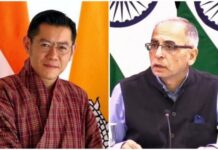At the recent NATO summit in Vilnius, world leaders expressed concern over Russia’s nuclear posture and the deployment of tactical nuclear weapons in Belarus, given the ongoing conflict between Russia and Western-backed Ukraine. Yet the international community also ought to pay attention to equally-as-important developments in the Indian subcontinent. A recent speech by Pakistan’s Lt. General Khalid Kidwai has sent shockwaves across the region, potentially signaling that Islamabad may have just changed its own nuclear doctrine, and not for the better.
If implemented, these changes could be highly destabilizing not just for the region, but also for the rest of the world. Washington ought to take notice and consider this development will affect its Indo-Pacific strategy.
The Nuclear “Horizontal” and “Vertical”
Kidwai’s speech, delivered on the 25th anniversary of Pakistan’s nuclear tests, matters for two major reasons.
The first reason is that it came from Kidwai himself. As the former head of the Strategic Plans Division—which administers all policies and strategies regarding Pakistan’s nuclear and missile programs—and an adviser to the country’s National Command Authority, Kidwai is one of Pakistan’s most senior and decorated generals. He has been described as the mastermind behind Pakistan’s nuclear policy and deterrence doctrines, and “the architect” of the country’s nuclear energy program. He is, in effect, the foremost author and authority on Pakistan’s nuclear strategy.
The second reason is what Kidwai actually said in his speech. In reiterating Pakistan’s nuclear deterrence strategy, Kidwai described the country’s ongoing efforts to ensure “full spectrum deterrence” (FSD), supported by a nuclear triad of land, air, and sea-based capabilities. This, in short, is Pakistan’s policy of having sufficient capabilities to able to respond to a wide range of threats—presumably originating from India.
Yet Kidwai went further, describing two dimensions of FSD: “horizontal,” which comprises of a robust tri-services inventory of a variety of nuclear weapons, and “vertical,” which encapsulates adequate range coverage of its vectors from “zero meters to 2,750 kilometers,” encapsulating “destructive yields suited for strategic, operational, and tactical levels.” Such an elaborate arsenal, he argued, provides Pakistan with a “strategic shield”, blunting the extant conventional asymmetry with India.
In other words, Kidwai is seemingly suggesting that Pakistan could or ought to develop short-range, potentially even front-line, nuclear weapons. These could include anything from nuclear artillery to even nuclear land mines.
“Zero Meters”
On one level, this proposed shift in nuclear doctrine, brazen as it may sound, is not out of the ordinary. Pakistan’s current doctrinal thinking and capability development are a result of the Indo-Pakistani War of 1971, which it lost. The conflict casts a long shadow over the psyche of the Pakistan’s military, resulting in a mindset that perceives nuclear weapons as the ultimate guarantor for the security of the country. Thus, the Pakistani military aims to undermine India’s military superiority through rapid nuclear weapons deployment and posturing of shallow thresholds.
Yet an obvious and significant problem arises when Pakistan doctrinally attempts to leverage nuclear weapons, especially its battlefield nuclear weapons, to support a policy of cross border terrorism.
Kidwai first explained the value of tactical nuclear weapons (TNWs) when the country’s very short-range ballistic missile, Nasr, was first tested in April 2011. He said that it would “pour cold water over Cold Start”—a reference to India’s own punitive response doctrine. Though it has since been dismissed by Indian military leaders, New Delhi has nevertheless developed a carefully curated punitive retaliation strategy against Pakistani-sponsored terror attacks. This, in effect, has shown up the inefficacy of Pakistan’s nuclear weapons. After all, of what use are TNWs as a deterrent if India can conduct careful retaliation attacks, far below the nuclear threshold, against Pakistani-supported terrorist attacks?
Nonetheless, Pakistan’s attraction for TNWs, or tactical nuclear responses in general, continues as a preventive deterrence measure, despite the growing asymmetry in conventional military capabilities between the two countries. In fact, Kidwai has now coined a new term called “zero meters.” While he has not explained its meaning, it has been interpreted to mean nuclear artillery shells, atomic demolition munitions, or nuclear land mines. Indeed, such TNWs—including naval cruise missiles carried on conventional submarines/ships, or shorter-range missiles—have generally existed since NATO deployed these weapons in Europe to deter the Soviet Union. Aping their strategy, Pakistan’s military command seems to believe that it can adroitly sequence warfighting into three neat levels, and that its variety of warheads and ranges of delivery systems would counter each move by India.
Yet as British historian and master strategist Lawrence David Freedman pointed out in the context of the NATO strategy, such matters would never unfold neatly, and TNWs could pose several substantial challenges. All this has been corroborated time and again via many wargames and exercises.
Courting Madness
India, for its part, has never accepted a step-by-step nuclear escalation ladder and instead pursues a doctrine of massive retaliation against any nuclear use, irrespective of how the first user describes the weapon or undertakes its use. It is astounding that Pakistani strategists believe that anything they do will be exempted from this doctrine.
The folly of this new Pakistani strategy is also being called out by Pakistani analysts. In a hard-hitting piece in Pakistan’s weekly Friday Times, Ejaz Haider, a prominent Pakistani journalist and commentator on defense issues, recounts classic nuclear deterrence literature to question how Kidwai’s “illogic of instability to create the logic of strategic stability” could even work. Sitara Noor, a prominent Pakistani nuclear analyst, enquired in Foreign Policy magazine that if the “strategic objective” of zero-range weapons is to deter a “newly perceived gap” after the conduct of surgical strikes by India, then how could they be used to country’s advantage? Irrespective of the logic driving such a strategy, she rightly finds it problematic for reasons of operational execution and regional stability.
It is heartening that Pakistani nuclear analysts are holding up a mirror to their misperceived nuclear doctrinal thinking anchored in the idea of “graduated warfighting.” Given the many unknowns that arise once a nuclear weapon, whatever it may be called, is used, the neat schema of nuclear use at every level that Kidwai seems to suggest is unlikely to play out as intended. This is dangerous and wholly destabilizing thinking in the extreme that could result in miscalculation and escalation.
It is worth considering the potential consequences of a deterrence breakdown and the resulting responses. “What” happens after a breakdown?
Not only would such a move prove suicidal for the first user, but it also would wreak widespread havoc on the region and beyond. It is the unconstrained effects of nuclear weapons that set them apart from even the greatest of all conventional bombs, and loose talk about them has been as much a taboo as their use or threat of use. Pakistan’s irresponsibility with its nuclear strategy could prove problematic well beyond its prime adversary.
In fact, it is ironic that Kidwai invoked Youm-e-Takbir, the day of greatness, to glorify the willingness of the Pakistani populace to accept deprivation for the sake of its nuclear weapons program. Even as his country is going through a period of unprecedented political and economic turmoil, even by its own standard, Kidwai seems to be, like Marie Antoinette’s apocryphal response, exhorting his countrymen to not despair for their lack of naans, but rejoice at the existence of nukes.
Concerns to Remember
Pakistan’s continued strategy of sub-conventional provocations and nuclear brinkmanship, to say nothing of its broader societal turmoil, are a shared concern for both India and the United States. In fact, the heavy military hand in Pakistan’s decisionmaking apparatus not only warps the democratic process but also tends to lean towards “first resort,” as highlighted by Ejaz Haider.
There are at least four major concerns regarding Pakistan that could have regional and even global implications, and should be viewed seriously.
First is the highly unstable political-economic environment within the country, including the possibility of social unrest spiraling out of control.
Second is the deep fissures within the Pakistan Army, as seen in the emergence of rival cliques of senior officers, which has with ripple effects through junior ranks. The tendency of the Army to periodically “rescue” the country from incapable democratic government was supported by a united military leadership. That does not seem to be the case any longer, which only grows as a cause for concern as the number of warheads grow, with a wide range of newer type of smaller and even more dispersed “nukes” joining the arsenal.
Third, current public outrage, especially in the Pakistani “heartland,” is unusual even for the seemingly Teflon-coated Pakistan Army. Consider the attack on May 9 on the Corps Commander’s house in the highly-protected Lahore garrison—this seems much more like a targeted attack than spontaneous outrage leading to more than a symbolic breaching of the walls.
Fourth, there is the role and influence of China in the proposed “0 to 2,750 km” nuclear strategy and arsenal. It is entirely possible that low-yield nuclear weapons for Pakistan’s naval platforms, especially the Chinese Yuan class submarines, are being produced. Technically, the challenge of warheads that fit into 533mm (21 inch) torpedo tubes is not insurmountable, and Beijing may have already helped resolve this. The plans and intent for a naval leg of nuclear deterrence are not new. But potentially nuclear naval cruise missiles carried in conventional submarines/ships/patrol aircraft could be highly destabilizing, since India does not see them as merely “tactical” or “operational.”
































